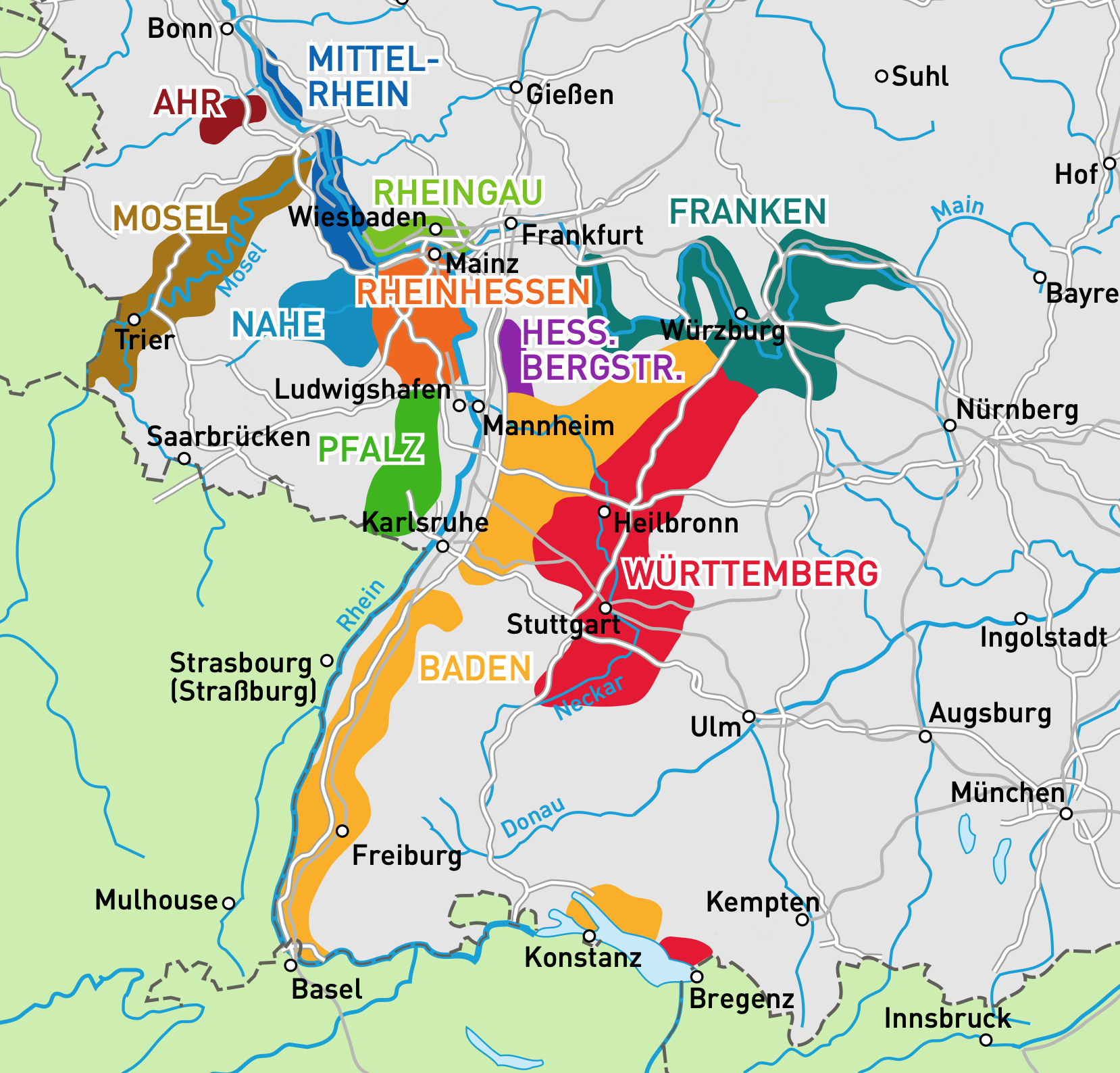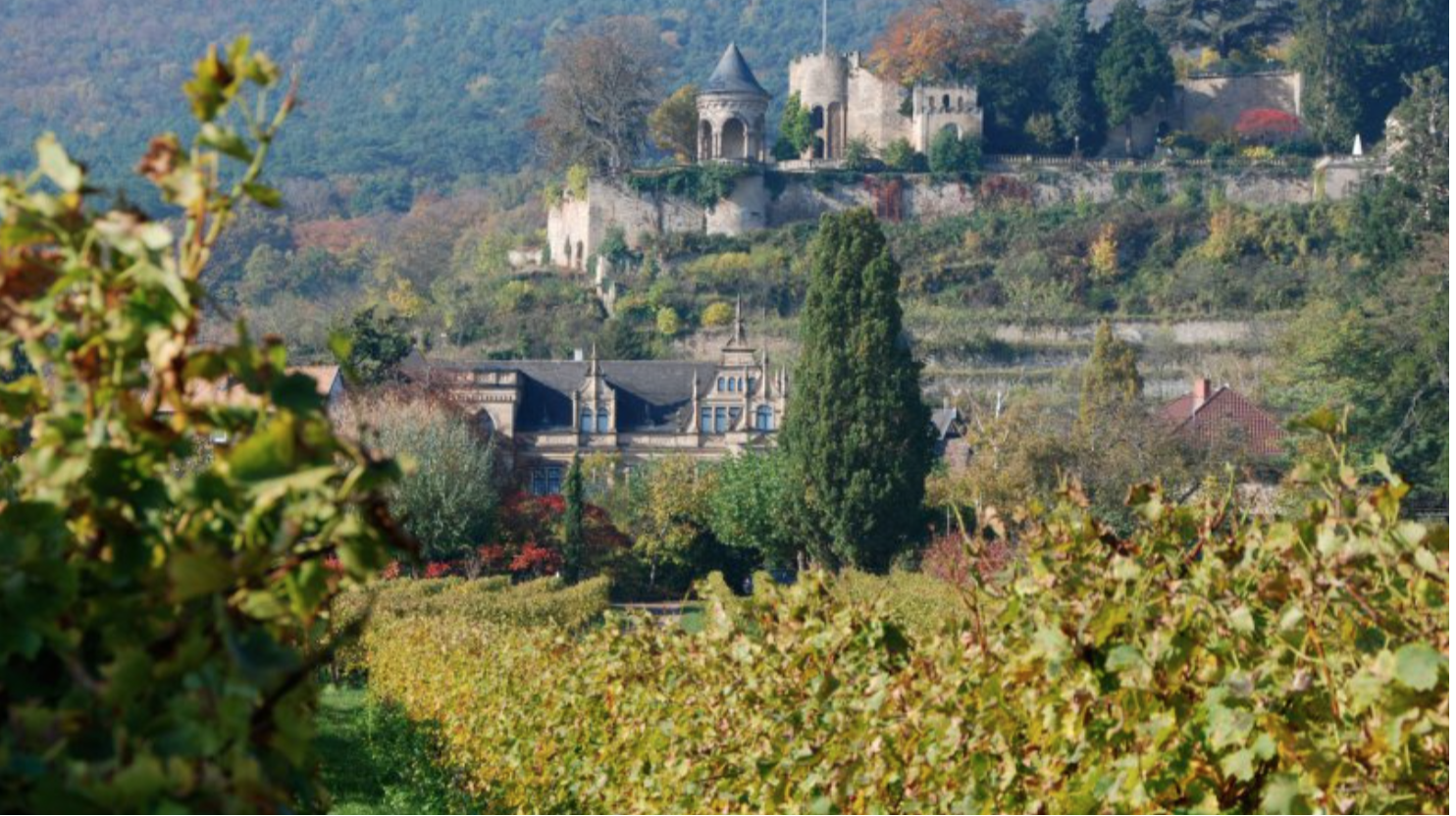To most people, German wine means German Riesling. Of course, Germany offers many other varieties, including Grauburgunder (Pinot Gris), Müller-Thurgau, Sylvaner, Spätburgunder (Pinot Noir), and Weissburgunder (Pinot Blanc). Germany actually has more acres of Pinot Blanc than any other country in the world and it is the third-largest grower of Pinot Gris. Still, German Riesling eclipses all those varieties in both acreage and reputation.
Germany has more than 57,000 vineyard acres of Riesling. It grows in every one of Germany’s 13 major wine regions, called Anbaugebiete. The most famous Anbaugebiete for high-quality German Riesling are Mosel, Rheingau, Nahe, Pfalz, and Rheinhessen.
About Riesling
Riesling is an aromatic, white wine grape that's native to Germany. It appeared in German books as early as 1552, but was clearly an important variety well before that. Riesling's specific origin is not 100% certain. But Rheingau was likely the “birthplace” and Gouais Blanc is certain to be one of its parents. The other parent is unknown.
Riesling is arguably the most viticulturally versatile of the world’s noble wine grapes. Its growing season begins relatively late. That means Riesling is less susceptible to frost in cold regions, but also less likely to over-ripen in warm ones. It’s not very susceptible to mildew and rot, so it can work in rainy and humid regions too.
According to Gregory Jones, a global expert on climate with respect to viticulture, Riesling thrives with average growing-season temperatures of 56—64° F, a range of eight degrees. That may seem like a narrow band, but is twice that of Pinot Noir, Pinot Gris, Viognier, Sangiovese, and Zinfandel. It's 25–33% broader than that of Chardonnay, Sauvignon Blanc, Cabernet Sauvignon, Grenache, Syrah, Merlot, Malbec, etc. And, as shown by the quality of Riesling in Rutherford and Barossa Valley, dry Riesling can succeed even if average temperatures exceed 64°.
The Character of Riesling Wines
Riesling reveals terroir more than many other varieties do. The differences between sites are seen by the types of fruit aromas and flavors found in the wines. Other nods to site include the degree to which the wines are floral or mineral, and the levels of acidity and potential alcohol.
Riesling is a high-acid variety with moderate for alcohol. Even when made into a late-harvest, dessert wine, Riesling generally maintains vivid acidity which balances that sugar. Alcohol in Riesling is often very low, especially in desert wines. But, in warm regions, ABV in dry Riesling can get moderately high. Body varies from low to high, depending on the amount of sugar and alcohol.
Fruit flavors in Riesling are generally citrus (usually lime, but sometimes lemon) and stone fruit (nectarine, peach, and apricot). Green apple notes aren’t unusual. The most common floral note is honeysuckle. Mineral characteristics include slate, wet rock, and kerosene. As Riesling ages, baking spice can emerge.

Top Regions for German Riesling
Mosel
The scenic Mosel Valley, named for the river which serpentines through it, is the world’s northernmost region for top-quality wine. Vineyards in the narrow valley are on steep slopes of blue slate. The steeper the slope the better, as that gives vines “stadium seating” for best sun exposure. Southern facings are key to optimizing ripeness. Even though the Mosel is smaller than many Anbaugebiete in Germany, it has more Einzellagen than any other. [An Einzellage is the smallest, most specific level regional designation in German wine law.] With more than 500, the Mosel has the most Einzellagen of all Aunbaugebiete.
 Mosel vineyards can have up to 80° slopes. Photo courtesy Markus Molitor
Mosel vineyards can have up to 80° slopes. Photo courtesy Markus Molitor
Mosel delivers fine-boned, sophisticated Rieslings. This is due to its high latitude, along with frequent cloud cover and rain. In addition, the blue slate doesn’t provide vine roots ready access to water. Alcohol content, even in dry, Mosel wines, is low. The fruit flavors can be intense, but lean toward the least ripe incarnations of each category. Prominent aromas of slate and wet stone are typical.
Premier growing areas for Riesling within the Mosel include, but are not limited to, the villages of Bernkastel, Brauneberg, Erden, Graach, Piesport, Ürzig, Wehlen, and Zeltingen. Note that, in the German language, the suffix “er” indicates possession. So, a wine label that says “Ürziger Würzgarten” designates the Würzgarten Einzellage which “belongs” to the village of Ürzig.
Rheingau
Though very different in character, the Rheingau is neck-and-neck with the Mosel qualitatively. It’s a tiny region, making only 2% of Germany’s wine, but the vineyards all have southern facings with unimpeded sun exposure. The northern ridge blocks cold winds. Rheingau's slate is predominantly red. That absorbs more heat from the sun than blue slate. That warmth is released to the vines at night. The red slate also holds more water.
Those four factors combine to make Rheingau Rieslings riper, fuller, and more powerful than those from the Mosel. Rheingau aromas and flavors reflect that with yellow stone fruit and even tropical notes.
Assmannhausen, Erbach, Geisenheim, Hallgarten, Johannisberg, Rüdesheim, and Winkel are among the top Rheingau villages for Riesling.
Nahe
The Nahe Anbaugebiet is southeast of the Mosel and southwest of the Rheingau. It’s at the northeast end of Nahe River, where it joins the Rhein. Though less distinguished for Riesling than the Mosel or Rheingau, Nahe quality has long been good. The very best vineyards have southern facings. Among the most respected producers are Dönnhoff, Schlossgut Diel, and Schafer-Frölich.
Pfalz
The Pfalz is a long, narrow Anbaugebiet. It's west of the Rhine, running north-south. If you travel straight south from the Pfalz, you’ll soon be in Alsace, France. This relatively southerly location brings more sun and a slightly longer growing season. The greater cumulative ripening allows Pfalz producers to excel with with Rieslings of dessert-level sweetness. Aside from that, there is no defining, region-wide character for the wines.
 Weingut Müller-Catoir in the Pfalz. Photo courtesy of Müller-Catoir
Weingut Müller-Catoir in the Pfalz. Photo courtesy of Müller-Catoir
With more vineyard acres than all Anbaugebiete except Rheinhessen, Pfalz is a high-volume producer. Historically its wines have been pleasant, rather than exciting. Certain producers have really stepped things up though, focusing on characterful, low-production wines. The stellar scores for wines from producers such as Rebholz, Bassermann-Jordan, Muller-Catoir, Christmann, and Reichsrat von Buhl reflect that.
Rheinessen
No Anbaugebiet has more planted acres nor makes more wine than Rheinhessen. Relative to most of the neighboring growing areas, Rheinhessen is broad and without slope. That allows for very large vineyards. Lying just across the river from Rheingau, the same range of hills protects it. And the flat terrain means it gets sun all day.
Rheinessen grows quite a few grape varieties, including Riesling, Müller-Thurgau, Silvaner, and Kerner which, by law, must make up at least 70% of the blend in Liebfraumilch, the region’s infamous, export-focused, sweet wine. However, on the right soils, the Riesling can make very nice, varietal wine. Over the past twenty years, Riesling’s share of total acreage has risen from about 10% to nearly 18%. It's now the most-planted variety there.
Over that same period several producers have taken new approaches to Riesling winegrowing. That’s led to a revolution in quality. These distinguished wines are world class.
Conclusion
German Riesling is both delicious and a big topic, too big for one blog article. This article covers Riesling in general and Germany’s top regions for it. The next article will cover the range of styles (ex. Kabinett, Auslese) and quality designations (ex. VDP Grosse Lage) for German Riesling.
In the meantime, here are some highlights from the great selection of German Riesling at JJ Buckley.
Mosel
2017 Markus Molitor Erdener Treppchen Riesling Beerenauslese Gold Kapsel
2018 Joh Jos Prum Graacher Himmelreich Riesling Spatlese
Rheingau
2015 Weingut Fred Prinz Hallgartener Jungfer Riesling Auslese
2014 Peter Jakob Kuhn Riesling Doosberg Grosses Gewachs
Nahe
2018 Donnhoff Niederhauser Hermannshohle Riesling Auslese
2014 Weingut Schafer-Frohlich Monzinger Halenberg Riesling Grosses Gewaechs
Pfalz
2017 Muller-Catoir Haardter Herzog Rieslaner Auslese
2016 Reichsrat von Buhl Forster Pechstein Riesling Grosses Gewaechs (Spatlese Trocken)
Reinhessen
2016 Weingut K. Wechsler Riesling Benn
2016 Weingut Keller Riesling G Max
JJ Buckley guest blogger Fred Swan is a San Francisco-based wine writer, and educator. His writing has appeared in The Tasting Panel, SOMM Journal, GuildSomm.com, Daily.SevenFifty.com, PlanetGrape.com, and his own site, FredSwan.Wine (formerly NorCalWine) among others. He teaches at the San Francisco Wine School. Fred is founder of Wine Writers' Educational Tours, an annual, educational conference for professional wine writers. He also leads private wine tours and conducts tastings and seminars in person and via Zoom. Fred’s certifications include WSET Diploma, Certified Sommelier, California Wine Appellation Specialist, Certified Specialist of Wine, French Wine Scholar, Italian Wine Professional, Napa Valley Wine Educator, Northwest Wine Appellation Specialist, and Level 3 WSET Educator. He's been awarded a fellowship by the Symposium for Professional Wine Writers three times.